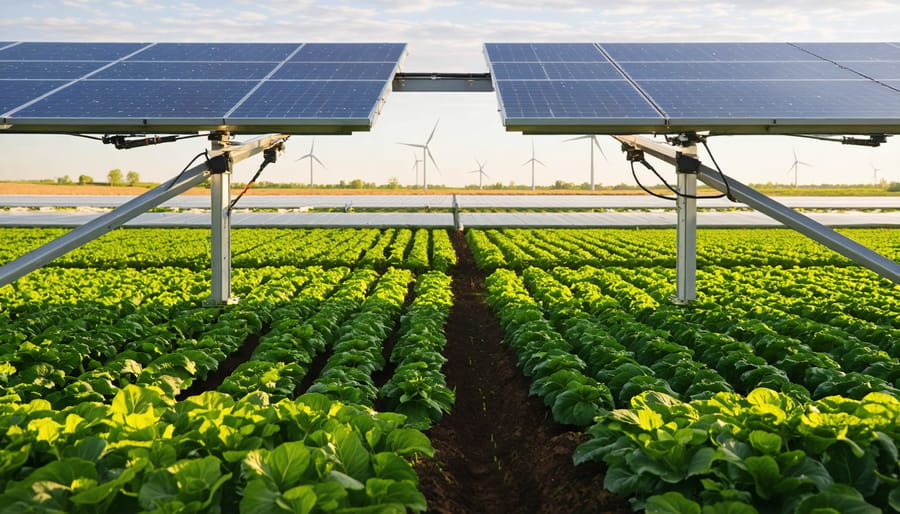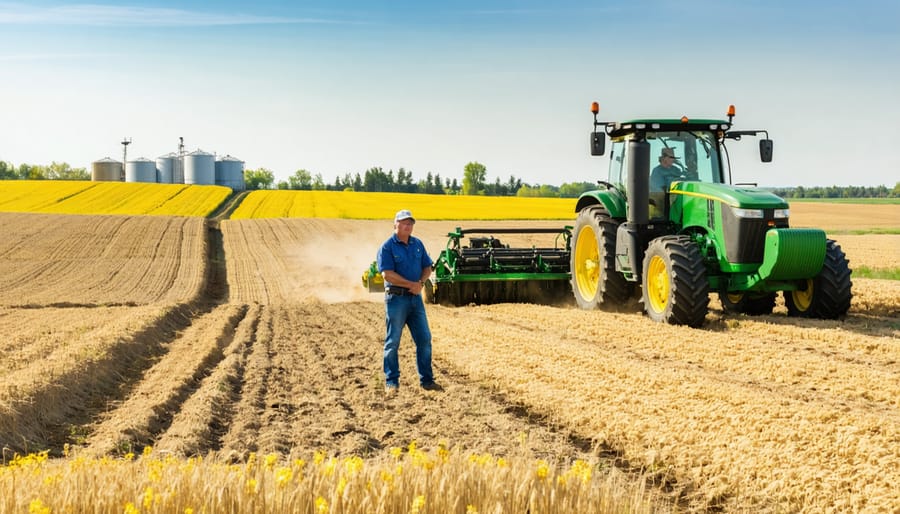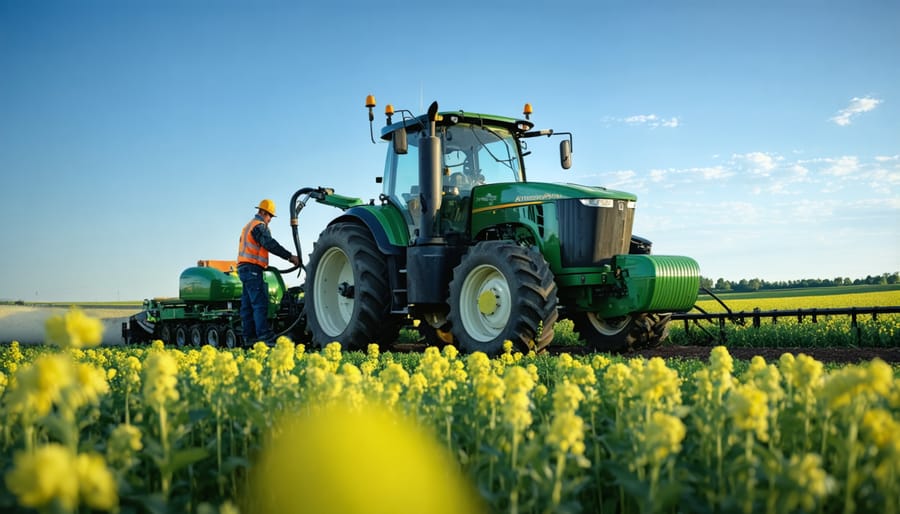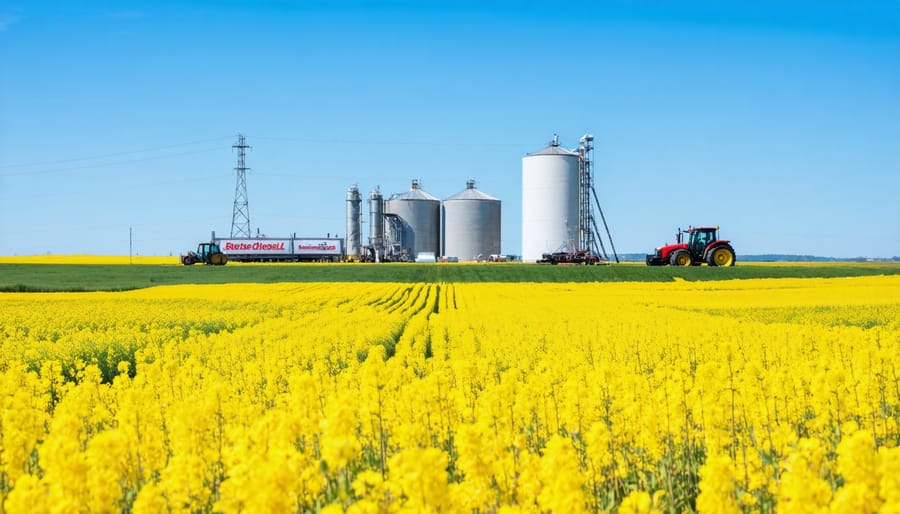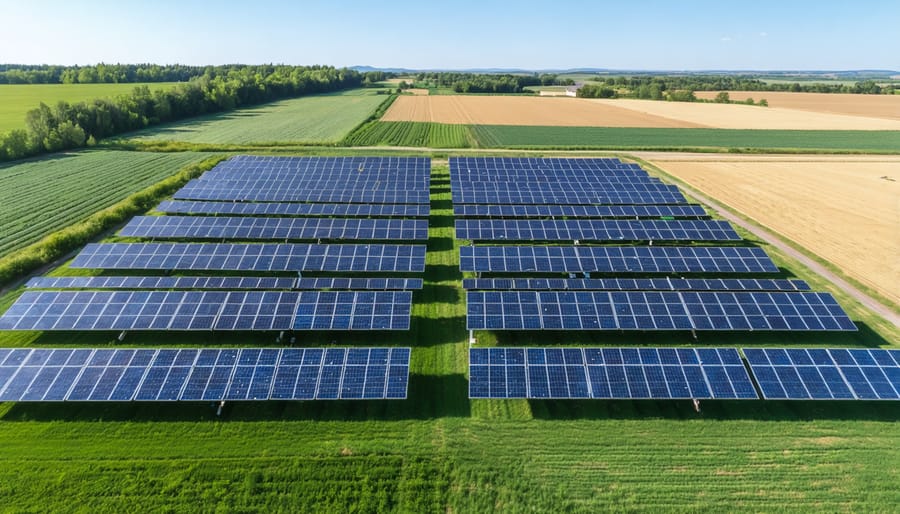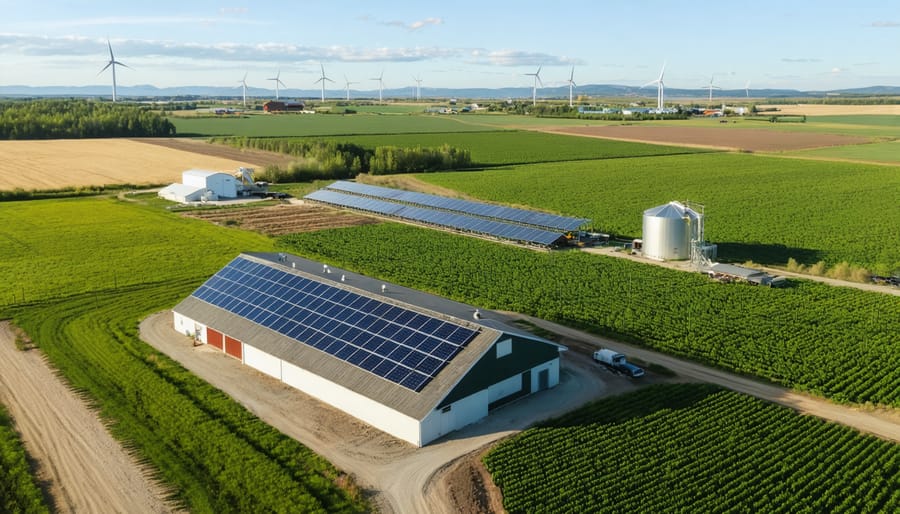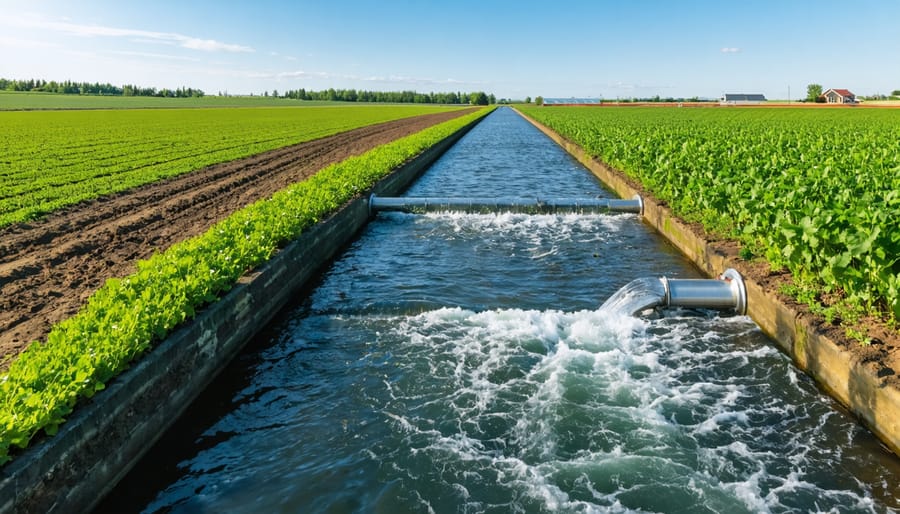As Alberta’s farming landscape transforms, carbon-free power projects are revolutionizing agricultural operations across the province. Local farmers are leading the charge, combining traditional agricultural wisdom with innovative clean energy solutions to slash operating costs and reduce environmental impact. From solar-powered irrigation systems in Lethbridge to wind energy installations near Red Deer, these initiatives are proving that sustainable farming isn’t just environmentally responsible – it’s economically smart.
Recent data from Alberta’s Agricultural Carbon Solutions Network shows that farms implementing carbon-free power systems are saving an average of $15,000 annually on energy costs while reducing their carbon footprint by up to 40%. With federal grants covering up to 50% of installation costs and provincial tax incentives making renewable energy more accessible than ever, the transition to carbon-free farming operations has never been more achievable.
This practical guide explores proven strategies from successful Alberta farms, breaking down the essential steps to implement carbon-free power solutions while maximizing available government support. Whether you’re managing a small family farm or overseeing large-scale operations, these locally-tested approaches offer a clear pathway to sustainable, profitable farming in Canada’s evolving agricultural landscape.
How Carbon-Free Power Projects Work on Canadian Farms
Solar Solutions for Alberta Farms
Alberta farmers are increasingly turning to solar power as a sustainable solution for their operations. Recent studies show that implementing solar and agricultural integration can reduce farm operating costs by up to 40% while maintaining productive land use.
Local success stories include the Henderson family farm near Lethbridge, which installed a 100kW system covering 450 square metres of their equipment shed. Their annual electricity bills dropped from $12,000 to $3,500, with the system paying for itself in just six years through energy savings and carbon credits.
The Alberta Solar Investment Program currently offers grants covering up to 35% of installation costs, making the initial investment more manageable. A typical 50kW system, suitable for a medium-sized farm operation, costs approximately $75,000 before incentives. With current rebates, farmers can expect to pay around $48,750, with financing options available through local agricultural credit unions.
Beyond cost savings, solar installations provide farmers with energy independence and resilience during power outages. Many systems now include storage capabilities, ensuring critical operations like irrigation and climate control remain functional during grid disruptions. The systems typically have a 25-year warranty and require minimal maintenance, usually just annual cleaning and inspection.
Local suppliers offer free site assessments to determine optimal system sizing and placement, considering factors like roof orientation, shading, and seasonal energy demands.
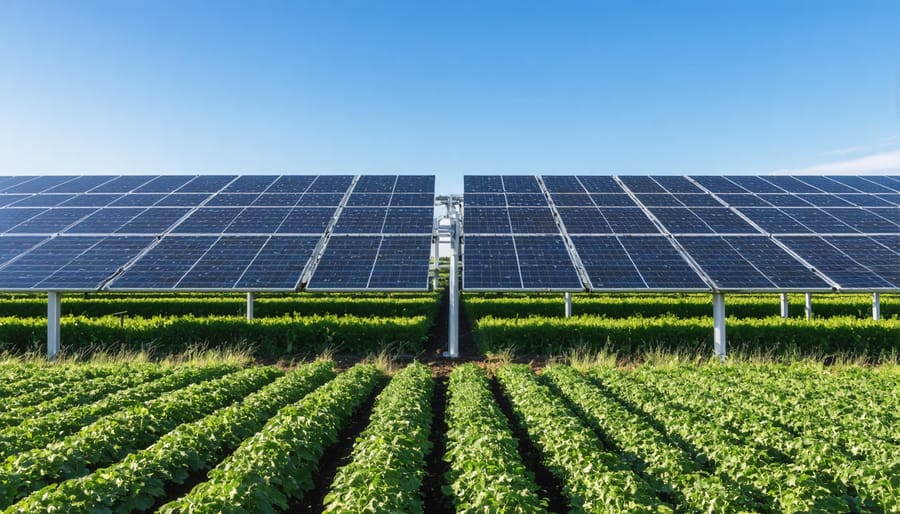
Wind Energy Integration
The integration of wind energy into agricultural operations has become increasingly viable across the Prairie provinces, with wind farms in Alberta leading the way in demonstrating successful implementations. For farmers considering wind power integration, the potential is particularly promising in regions experiencing consistent wind patterns above 6.5 metres per second at hub height.
Local success stories include the Henderson family farm near Pincher Creek, which installed a 100kW turbine that now powers their entire irrigation system and grain storage facilities. Their annual energy savings have exceeded $15,000, with excess power being fed back into the grid for additional income.
Modern wind turbines are specifically designed for agricultural applications, with heights ranging from 30 to 50 metres – ideal for farmland installation. These systems can be strategically placed to minimize impact on cropland while maximizing power generation. Many farmers report that livestock quickly adapt to the presence of turbines, and crops can be grown right up to the base of the structures.
For those interested in implementation, the Alberta Agricultural Renewable Energy Program offers grants covering up to 50% of installation costs. Working with local wind assessment specialists can help determine optimal turbine placement and expected power generation based on your specific location and energy needs.
Remember to consider factors such as grid connection requirements, maintenance schedules, and seasonal wind variations when planning your wind energy integration project.
Real Results: Alberta Farm Case Studies
The Miller Family’s Solar Success
The Miller Family Dairy Farm in Lacombe County, Alberta, stands as a shining example of successful solar-powered farm operations. In 2019, John and Sarah Miller made the bold decision to transition their 200-hectare dairy operation to solar power, addressing both their environmental concerns and rising electricity costs.
The farm installed a 75-kilowatt solar array system, strategically placed on their south-facing barn roof. This installation now powers their entire milking operation, including the automated milking system, milk cooling equipment, and ventilation systems. The Millers worked closely with local solar contractors and utilized the Alberta Agricultural Solar Power Investment Program, which covered 35% of their initial installation costs.
“The change has been remarkable,” shares Sarah Miller. “Our monthly electricity bills have dropped by 80%, and we’re producing enough excess power in summer months to earn credits through Alberta’s net metering program.” The family’s investment of $180,000 is expected to pay for itself within seven years, significantly ahead of initial projections.
The system has proven particularly effective during peak milking times, when power demands are highest. Even during Alberta’s winter months, the solar array maintains 60-70% efficiency, supplemented by grid power when needed. The Millers have also noted unexpected benefits, including reduced maintenance costs and improved energy security during grid outages.
Their success has inspired neighbouring farms, with five other local dairy operations following their lead in the past two years. The Millers regularly host farm tours, sharing their experience and helping other farmers understand the practical aspects of solar conversion.
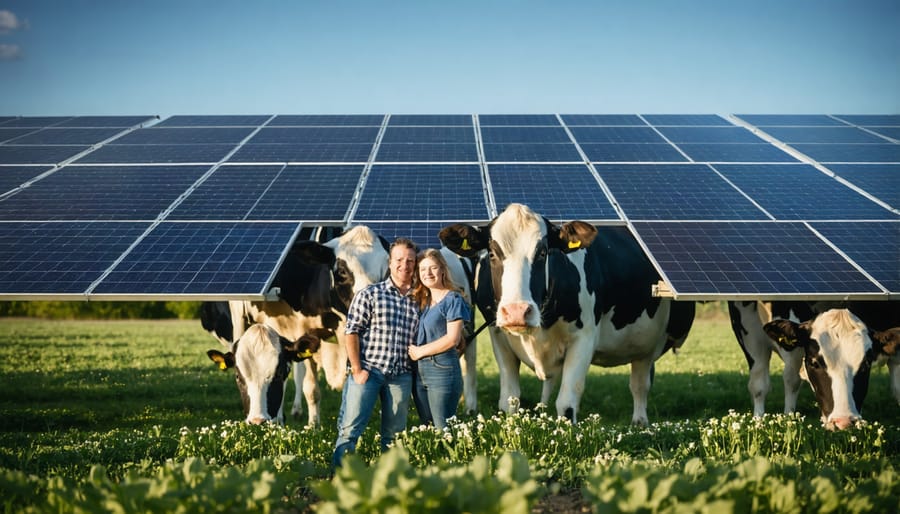
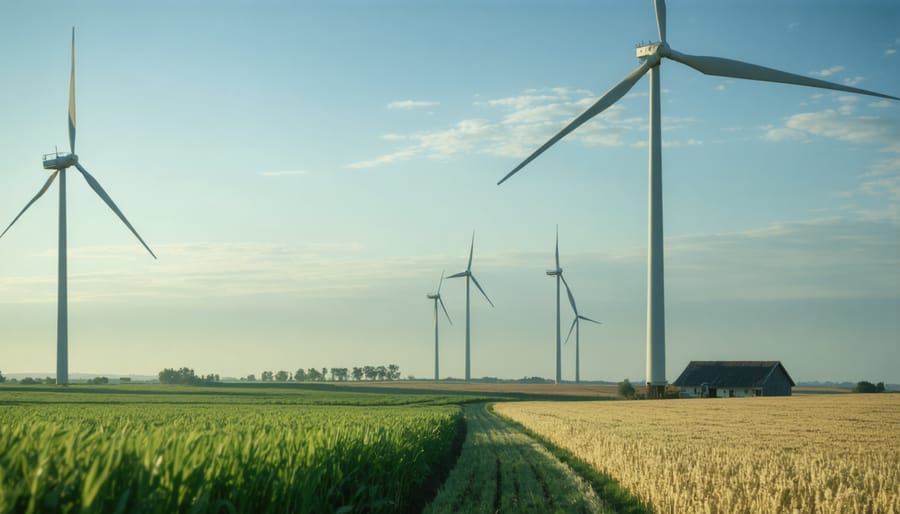
Green Acres: Wind-Powered Grain Production
Located just outside of Red Deer, Alberta, the Thompson family farm has transformed their 2,000-hectare grain operation into a model of sustainable agriculture through wind power integration. In 2019, they installed three 2.3-megawatt wind turbines, which now generate enough electricity to power their entire operation, including grain drying facilities, storage systems, and irrigation equipment.
“The decision to switch to wind power wasn’t just environmental – it made financial sense,” explains Sarah Thompson, third-generation farmer and project lead. “With Alberta’s consistent wind patterns and the rising costs of traditional power sources, we saw an opportunity to secure our farm’s energy future.”
The installation required an initial investment of $4.2 million, partially offset by federal clean energy incentives and provincial agricultural grants. The Thompsons worked closely with local renewable energy experts and agricultural engineers to optimize turbine placement, ensuring minimal impact on farming operations while maximizing power generation.
The results have exceeded expectations. Annual power costs have decreased by 85%, with excess energy being sold back to the grid during peak production periods. The wind turbines generate approximately 18,000 megawatt-hours annually, with particularly strong output during the crucial harvest season when power demands are highest.
The project has inspired neighboring farms to explore similar initiatives. “We’re seeing a real shift in mindset,” Sarah notes. “More farmers are realizing that sustainable practices and profitable farming go hand in hand.” The Thompsons regularly host farm tours and workshops, sharing their experience and helping other Alberta farmers understand the practical aspects of wind power implementation.
Financial Benefits and Support Programs
Government Incentives for Clean Energy
Canadian farmers looking to transition to clean energy solutions can access several substantial government incentives. The Federal government’s Agricultural Clean Technology Program offers grants covering up to 50% of project costs for clean energy installations, with a maximum funding of $2 million for individual farm operations.
Alberta-based farmers can additionally benefit from the province’s Energy Savings for Business Program, which provides rebates of up to $250,000 for implementing renewable energy systems. Solar installations are particularly well-supported, with rebates ranging from $0.75 to $1.00 per watt installed, making it significantly more affordable to harness the region’s abundant sunshine.
The Canada Greener Homes Grant, while primarily residential, extends to farm properties with qualifying living quarters, offering up to $5,000 for energy-efficient improvements. For larger agricultural operations, the Industrial Energy Efficiency Program provides funding for comprehensive energy audits and implementation of clean energy solutions.
Tax benefits are equally attractive, with accelerated capital cost allowance rates allowing farmers to write off clean energy equipment more quickly. The Clean Technology Tax Incentive permits up to 30% of qualifying expenses to be deducted from taxable income in the first year.
Remember to consult with local agricultural extension offices or renewable energy specialists to identify the most advantageous combination of incentives for your specific operation. Many programs offer additional support for new applicants through the application process.
Cost Analysis and Return on Investment
Understanding the financial aspects of carbon-free power projects is crucial for making informed decisions. Our analysis shows that initial implementation costs for a typical 100-hectare farm in Alberta range from $75,000 to $150,000, depending on the chosen technologies and scale of implementation. However, renewable energy investment returns typically show a break-even point within 5-7 years.
Local farmers have reported annual energy cost savings of 40-60% after transitioning to carbon-free systems. For example, the Davidson Family Farm in Red Deer County reduced their annual power expenses by $12,000 while qualifying for $25,000 in provincial green energy rebates.
Current government incentives can offset up to 30% of initial costs through programs like the Canadian Agricultural Partnership (CAP) and Alberta’s On-Farm Energy Management Program. Additionally, carbon credit trading opportunities can generate supplementary income, with participating farms earning an average of $5,000-$8,000 annually.
Maintenance costs are relatively low, averaging $1,500-$2,500 per year, significantly less than traditional power systems. Many farmers report increased property values, with renewable energy installations adding an estimated 4-6% to their farm’s market value.
When factoring in rising traditional energy costs and available incentives, the long-term financial benefits make carbon-free power projects an increasingly attractive investment for Alberta’s agricultural community.
Getting Started with Your Farm’s Carbon-Free Project
Starting your farm’s transition to carbon-free power begins with a clear assessment of your current energy needs and available resources. First, conduct an energy audit to understand your farm’s consumption patterns – this includes tracking electricity usage for equipment, buildings, and seasonal operations. Many Alberta agricultural extension offices offer free or low-cost energy assessment services to help you get started.
Next, evaluate your property’s renewable energy potential. Consider factors like average sun hours for solar panels, wind patterns for turbines, and available space for installation. Local weather data from Environment Canada can provide valuable insights for this planning stage.
Create a detailed implementation timeline that aligns with your farming calendar. Many farmers find success in phasing their renewable energy projects, starting with smaller installations and expanding over time. For example, you might begin with solar panels on your main barn before expanding to other buildings or adding wind power components.
Don’t overlook the importance of professional consultation. Connect with certified renewable energy installers who have experience with agricultural projects in Alberta. They can help you navigate technical requirements, permitting processes, and grid connection procedures. The Alberta Clean Technology Industry Alliance maintains a directory of qualified contractors.
Financial planning is crucial. Research available grants and incentives through programs like the Canadian Agricultural Partnership and Alberta’s Emissions Reduction Alberta initiative. Many farmers successfully combine federal and provincial funding to offset initial costs. Consider speaking with an agricultural financial advisor who understands renewable energy investments.
Build relationships with neighbouring farms that have already implemented similar projects. The Alberta agricultural community is known for its collaborative spirit, and experienced farmers are often willing to share insights and lessons learned. Consider joining local agricultural sustainability networks or attending renewable energy workshops offered by farming associations.
Remember to document your progress and maintain detailed records of your energy production and consumption. This data will be valuable for future expansion plans and can help other farmers in your community who are considering similar projects.
The transition to carbon-free power presents a transformative opportunity for Alberta’s agricultural community. As we’ve seen through numerous local success stories, farmers across the province are already reaping the benefits of renewable energy systems – from reduced operational costs to enhanced farm resilience and increased property values.
By embracing carbon-free power solutions, our farming communities are not only contributing to environmental sustainability but are also securing their economic future. The available grants, tax incentives, and support programs make this transition more accessible than ever, while the proven return on investment ensures long-term financial stability.
Looking ahead, the adoption of carbon-free power technologies positions Canadian farms at the forefront of agricultural innovation. These systems offer protection against rising energy costs while creating new revenue streams through energy export programs. Moreover, they strengthen our farming communities’ independence and resilience in the face of changing market conditions.
The time to act is now. With established technologies, supportive policies, and a growing network of experienced installers and maintenance providers, Alberta farmers have all the tools needed to make this transition successful. By working together and sharing our experiences, we can build a stronger, more sustainable agricultural sector that benefits current and future generations.
Take the first step today by connecting with local renewable energy experts or reaching out to fellow farmers who have already made the switch. Your farm’s sustainable future starts with one decision to embrace carbon-free power.

